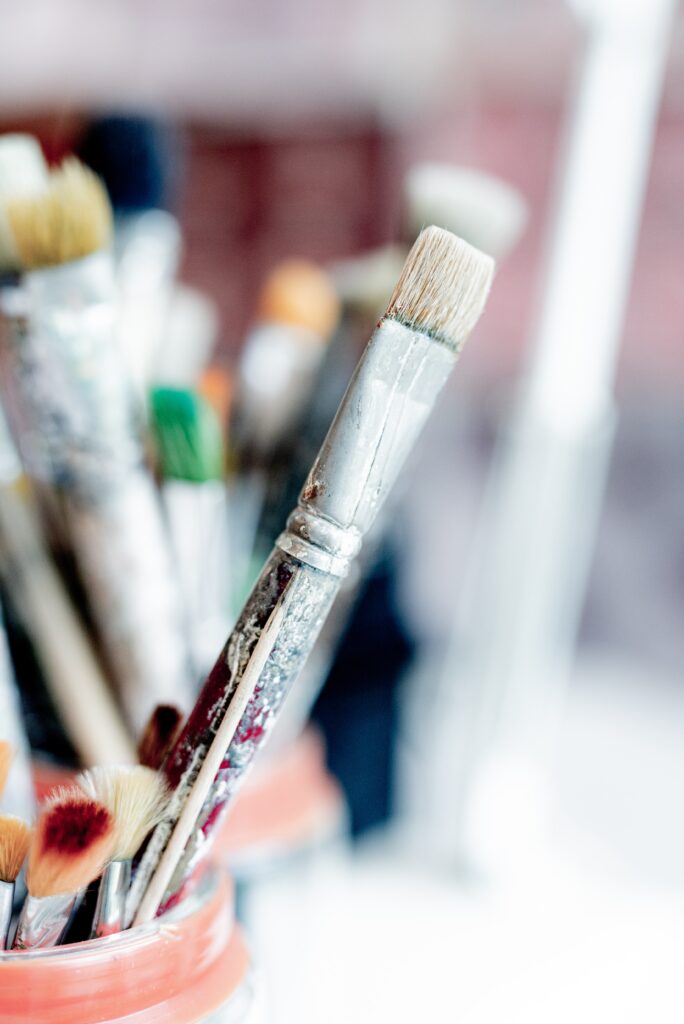Have you ever wondered if you can mix acrylic and latex paint? It’s a common question among painters, whether they’re beginners or experienced artists. Acrylic and latex paints are both versatile and popular choices, but their chemical compositions differ. In this article, we’ll explore whether it’s possible to mix these two types of paint and what the potential outcomes may be. So, if you’ve ever found yourself pondering this artistic conundrum, keep reading to find out more.
Understanding Acrylic Paint
Acrylic paint is a water-based paint that is made of pigment particles suspended in an acrylic polymer emulsion. It is known for its versatility and ability to adhere well to a variety of surfaces. Acrylic paint is available in a wide range of colors and finishes, from matte to glossy. It is a popular choice among artists, as it dries quickly and allows for easy mixing and layering of colors.
Properties of Acrylic Paint
Acrylic paint has several important properties that make it unique. Firstly, it is water-soluble, which means that it can be thinned and cleaned up with water. This makes it easy to work with and reduces the need for harsh chemicals. Acrylic paint is also known for its flexibility, which allows it to expand and contract without cracking or peeling. Additionally, it has excellent color fastness, meaning that the colors remain vibrant and true over time.
Advantages of Acrylic Paint
There are several advantages to using acrylic paint. One of the main advantages is its quick drying time. Unlike oil-based paints, which can take days to fully dry, acrylic paint dries within minutes to hours, depending on the thickness of the layers applied. This allows artists to work more quickly and make changes to their artwork without long waiting periods.
Another advantage of acrylic paint is its versatility. It can be applied to a variety of surfaces, including canvas, wood, paper, and even metal. It provides a smooth, even coverage and can be easily mixed to create custom colors and gradients. Additionally, acrylic paint is known for its durability. Once dry, it forms a tough and flexible film that is resistant to cracking and fading.
Disadvantages of Acrylic Paint
While acrylic paint has many advantages, there are also some disadvantages to consider. One disadvantage is that acrylic paint can dry too quickly, especially in hot and dry conditions. This can make it challenging to blend colors or create smooth transitions. To overcome this, artists may need to work fast or use additional mediums to extend the drying time.
Another disadvantage of acrylic paint is its potential for color shift. When wet, acrylic paint may appear darker than it actually is when dry. This can make it difficult to accurately predict the final outcome of a painting. To overcome this, artists often create color swatches or use a varnish to enhance the vibrancy of the colors.
Understanding Latex Paint
Latex paint, also known as water-based paint, is a type of paint that uses latex as the binder. It is commonly used for interior and exterior house painting and is known for its ease of use and durability. Latex paint is available in a wide range of colors and finishes, from flat to high gloss.
Properties of Latex Paint
Latex paint has several properties that make it a popular choice for both professional painters and DIY enthusiasts. Firstly, it is water-soluble, making it easy to clean up with soap and water. This reduces the need for harsh chemicals and makes it safe for indoor use.
Latex paint is also known for its quick drying time. It typically dries within a few hours, allowing for multiple coats to be applied in a single day. Additionally, latex paint has good color retention, meaning that the colors stay true and vibrant over time. It is also resistant to cracking and peeling, making it a durable option for both interior and exterior surfaces.
Advantages of Latex Paint
One of the main advantages of latex paint is its ease of use. It can be applied with a brush, roller, or sprayer, and requires minimal preparation compared to other types of paint. Additionally, latex paint has low odor, making it more pleasant to work with, especially for those with sensitivities to strong smells.
Another advantage of latex paint is its excellent adhesion. It adheres well to a variety of surfaces, including wood, drywall, and concrete. This makes it suitable for a wide range of projects, from painting walls to refinishing furniture. Latex paint also has good resistance to fading and yellowing, which allows the colors to remain bright and vibrant over time.
Disadvantages of Latex Paint
While latex paint has many advantages, there are also some disadvantages to consider. One disadvantage is that it can be more difficult to achieve a smooth, brushstroke-free finish compared to oil-based paints. This is especially noticeable with glossy or semi-gloss finishes, where brush strokes may be more visible.
Another disadvantage of latex paint is its limited color selection in certain brands or product lines. While there are still a wide range of colors available, some specialty or specific shades may be harder to find in latex paint compared to other types of paint. Additionally, latex paint may not adhere well to surfaces that have been previously painted with oil-based paint without proper preparation.

Key Differences between Acrylic and Latex Paint
While acrylic and latex paint have several similarities, there are also key differences to consider when choosing the right paint for your project.
Chemical Composition
The main difference between acrylic and latex paint lies in their chemical composition. Acrylic paint is made up of pigment particles suspended in an acrylic polymer emulsion, while latex paint uses latex as the binder. This difference in binders affects the overall performance and characteristics of each paint type.
Film Formation
Another difference is how the two types of paint form a film as they dry. Acrylic paint forms a hard and flexible film due to its acrylic polymer emulsion binder. On the other hand, latex paint forms a softer and more elastic film due to the latex binder. This difference in film formation affects the overall durability and flexibility of the paint.
Drying Time
Acrylic paint generally has a quicker drying time compared to latex paint. Acrylic paint typically dries within minutes to hours, depending on the thickness of the layers applied. In contrast, latex paint takes a few hours to dry, allowing for multiple coats to be applied in a single day.
Durability
In terms of durability, acrylic paint is known for its toughness and resistance to cracking and fading. Once dry, it forms a tough and flexible film that can withstand various environmental conditions. Latex paint is also durable, but it may not be as resistant to extreme weather conditions or high-traffic areas.
Color Retention
Both acrylic and latex paint have good color retention, meaning that the colors stay vibrant and true over time. However, acrylic paint may have a slight advantage in terms of color fastness, as it is less prone to yellowing or fading compared to latex paint.
Potential Issues with Mixing Acrylic and Latex Paint
Although it is possible to mix acrylic and latex paint, there are potential issues that can arise when doing so. It is important to be aware of these issues before attempting to mix the two paints.
Incompatible Binders
One of the main issues with mixing acrylic and latex paint is that they have different binders. Acrylic paint uses an acrylic polymer emulsion as its binder, while latex paint uses latex as its binder. These different binders may not blend well together and can lead to issues such as poor adhesion and improper film formation.
Adhesion Problems
Mixing acrylic and latex paint can also result in adhesion problems. The different binders in the paints may not adhere properly to the surface or even to each other. This can cause the paint to peel or flake off over time, compromising the overall appearance and durability of the painted surface.
Cracking and Peeling
Another issue that can arise from mixing acrylic and latex paint is cracking and peeling. The different binders and drying times of the two paints can create tension and stress within the paint film. This can lead to cracking and peeling, especially when applied in thick layers or on flexible surfaces.
Uneven Drying
Mixing acrylic and latex paint can also result in uneven drying. The different drying times and characteristics of the paints can cause some areas to dry faster than others. This can create visible lines or patches on the painted surface, affecting the overall finish and appearance of the project.
Color and Texture Variation
Lastly, mixing acrylic and latex paint can result in color and texture variation. The different properties and pigments of the two paints may not blend evenly, leading to color variations or streaks. This can be especially noticeable when using transparent or glazing techniques.

Considerations when Mixing Acrylic and Latex Paint
If you still decide to mix acrylic and latex paint despite the potential issues, there are several considerations to keep in mind.
Use as Undercoat or Topcoat
One option is to use acrylic paint as an undercoat and latex paint as a topcoat. In this case, the different characteristics and drying times of the two paints can be advantageous. The acrylic undercoat can provide a smooth and durable base, while the latex topcoat can provide a protective and weather-resistant finish.
Small Projects vs. Large Surfaces
Mixing acrylic and latex paint may be more suitable for small projects or areas that will not be subjected to heavy wear and tear. In these cases, the potential issues with adhesion, cracking, and uneven drying may be less problematic. For larger surfaces or high-traffic areas, it is generally recommended to use a single type of paint for better consistency and durability.
Testing Compatibility
Before mixing acrylic and latex paint, it is important to test the compatibility of the two paints. This can be done by applying a small amount of the mixed paint to a test surface or spare material. Allow it to dry completely and check for any signs of adhesion problems, cracking, or peeling. If the test results are satisfactory, you may proceed with mixing the paints for your project.
Proper Mixing Techniques
When mixing acrylic and latex paint, it is important to use proper mixing techniques to ensure a homogeneous blend. Start by pouring equal amounts of each paint into a clean container. Use a stir stick or palette knife to thoroughly mix the paints together until a consistent color and texture is achieved. Avoid overmixing, as this can introduce air bubbles and affect the overall performance of the paint.
Tips for Successfully Mixing Acrylic and Latex Paint
If you are determined to mix acrylic and latex paint, here are some tips to help you achieve the best results.
Choose Quality Paints
Using high-quality acrylic and latex paints can increase the chances of a successful mix. Quality paints are formulated with consistent binders and pigments, reducing the risk of compatibility issues and ensuring better performance and durability.
Prepare the Surface
Proper surface preparation is crucial when working with mixed paints. Ensure that the surface is clean, dry, and free from any loose debris or contaminants. Consider using a primer or undercoat to enhance adhesion and create a smooth base for the mixed paint.
Mix Paints in Small Batches
To maintain consistency and prevent wastage, it is recommended to mix paints in small batches. This allows better control over the color and texture of the mixed paint, as well as minimizes the risk of drying or curing before it can be applied.
Adhere to Mixing Ratios
When mixing acrylic and latex paint, it is important to follow the recommended mixing ratios. These ratios can vary depending on the desired color, opacity, and consistency of the mixed paint. Deviating from the recommended ratios can affect the overall performance and durability of the paint.

Alternative Options for Achieving Desired Results
If the potential issues and considerations seem too daunting or if you prefer a more predictable outcome, there are alternative options to consider for achieving your desired results.
Using Primer
Instead of mixing acrylic and latex paint, consider using a primer specifically designed for the surface you are working on. Primers provide a consistent base for paint adhesion and ensure better coverage and durability. Choose a primer that is compatible with the type of paint you plan to use.
Layering Techniques
Layering techniques can be used to create depth and variation in colors without the need to mix different types of paint. Start with a base layer of acrylic paint and allow it to dry completely. Then, apply thin layers of latex paint on top, using brushstrokes or other techniques to create texture and interest.
Blending Techniques
If you are looking to achieve a specific color or gradient, consider using blending techniques instead of mixing paints. This involves layering different colors or shades of the same paint type and using brushes or other tools to blend and transition between them. This allows for more control over the final result and reduces the risk of compatibility issues.
Frequently Asked Questions
Can you mix acrylic and latex paint for exterior surfaces?
While it is possible to mix acrylic and latex paint for exterior surfaces, it is generally not recommended. Exterior surfaces are exposed to harsh weather conditions and fluctuations in temperature, which can affect the performance and durability of the mixed paint. It is best to use a single type of paint that is specifically formulated for exterior use to ensure better longevity and resistance.
Can you mix acrylic and latex paint for interior surfaces?
Mixing acrylic and latex paint for interior surfaces is more feasible, especially for small projects or areas that are not subjected to heavy wear and tear. However, it is still important to consider the potential issues and follow proper mixing techniques and surface preparation to achieve satisfactory results. It is recommended to test the compatibility of the mixed paint on a small area before applying it to larger surfaces.
Can you mix acrylic and latex paint for art projects?
Mixing acrylic and latex paint for art projects is a common practice among artists looking for unique effects or textures. However, it is important to be aware of the potential issues and limitations that may arise when mixing these two types of paint. It is recommended to experiment and test different mixtures on small samples or practice pieces before applying them to final artwork.



